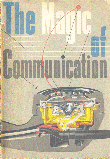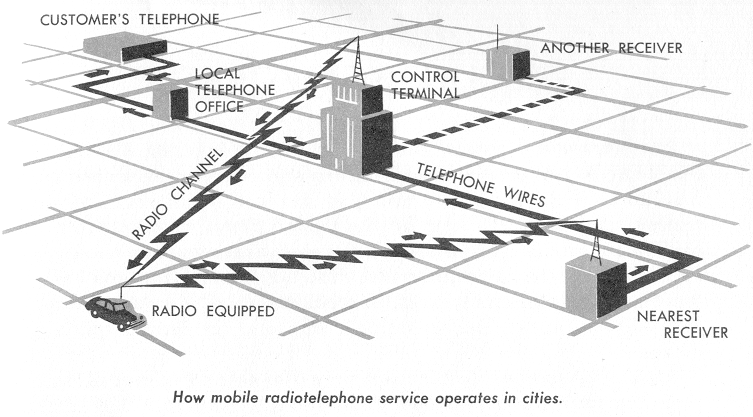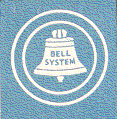 [This is excerpted from The Magic of Communication, published
by the Bell Telephone System in 1954.]
[This is excerpted from The Magic of Communication, published
by the Bell Telephone System in 1954.]
Bell System mobile telephone service provides two-way voice communication for motor vehicles and other mobile units in most of the major cities and on many highways throughout the United States. At present there are about 14,000 "traveling telephones" in service, and they are used to make and receive close to 5,000,000 calls a year.
Mobile service is another means of furnishing telephone service to watercraft. Vessels in harbors and those plying inland waterways adjacent to highways where mobile service is available, may use the same or similar facilities as automobiles and trucks. Regular telephone service also is being provided on an increasing number of passenger trains throughout the country.
A subscriber to the general two-way mobile service is able to talk from his truck or car to any one of the millions of telephones connected to the regular telephone network. Likewise, his vehicle can be called from any one of the millions of telephones.

The general mobile radiotelephone service operates like this:
Calls to and from vehicles are handled by mobile service operators.
The conversations travel part way by telephone wire and part way
by radio. For example, a man at his office desk who wants to talk
to someone in a certain car or truck lifts his telephone receiver
and dials or asks for long distance. He then asks for the mobile
service operator, to whom he gives the telephone number of the
vehicle. Numbers such as WJ 6-6632, which do not conflict with
any other numbers, are used.
The operator sends over the radio channel a signal which selects the particular mobile telephone desired and causes a bell to ring and a light to go on in the car or truck. When the driver sees or hears his signal he answers his telephone. His voice travels by radio to the nearest receiving station and thence by telephone wire back to the caller.
The person in the vehicle presses a button on his telephone to talk, releases it to listen.
In large cities a number of receiving stations are located throughout the area so that the relatively low-powered radio transmitters in the vehicles are within range of a land receiver at all times. One of the receiving sets near the mobile unit picks up the voice signals and sends them on their way by telephone wire. Outside cities, transmitting and receiving stations are located along the highways being served.
 Private mobile equipment can be leased from and maintained by the
telephone company. It provides two-way direct radio communication
between the customer's vehicles and a transmitting station on the
customer's premises. Arrangements can be made so that the vehicles
also can communicate with one another. The equipment is widely used
by industries and governmental agencies.
Private mobile equipment can be leased from and maintained by the
telephone company. It provides two-way direct radio communication
between the customer's vehicles and a transmitting station on the
customer's premises. Arrangements can be made so that the vehicles
also can communicate with one another. The equipment is widely used
by industries and governmental agencies.